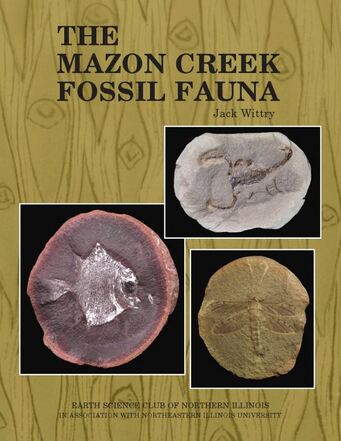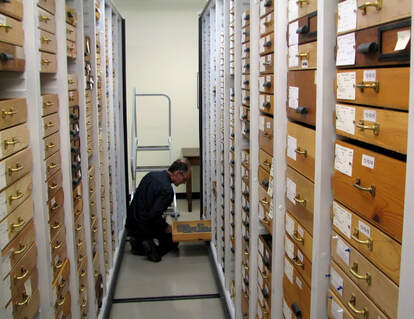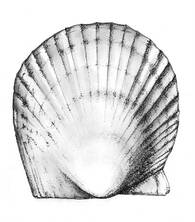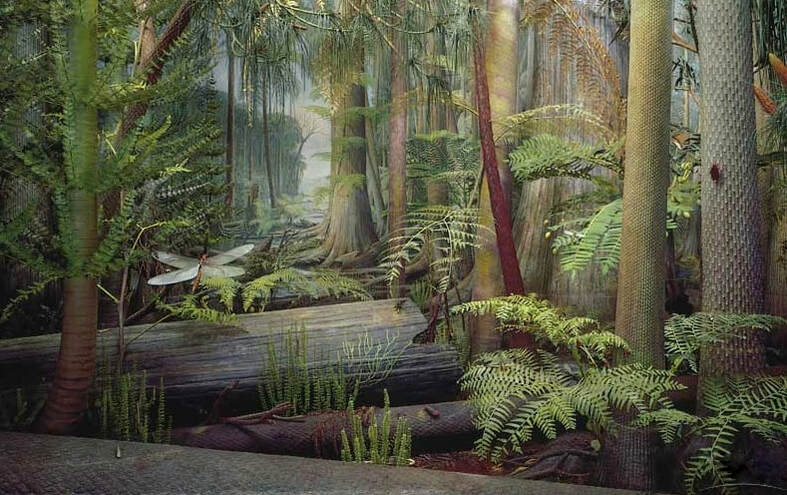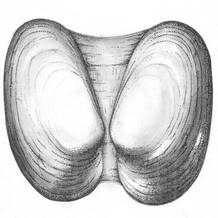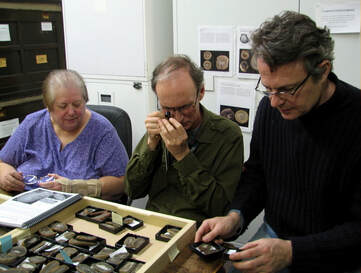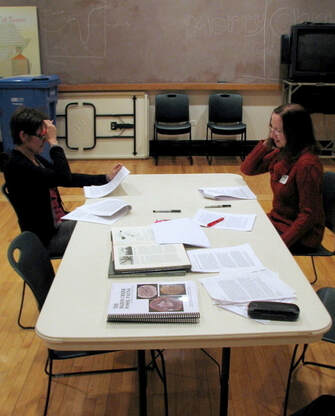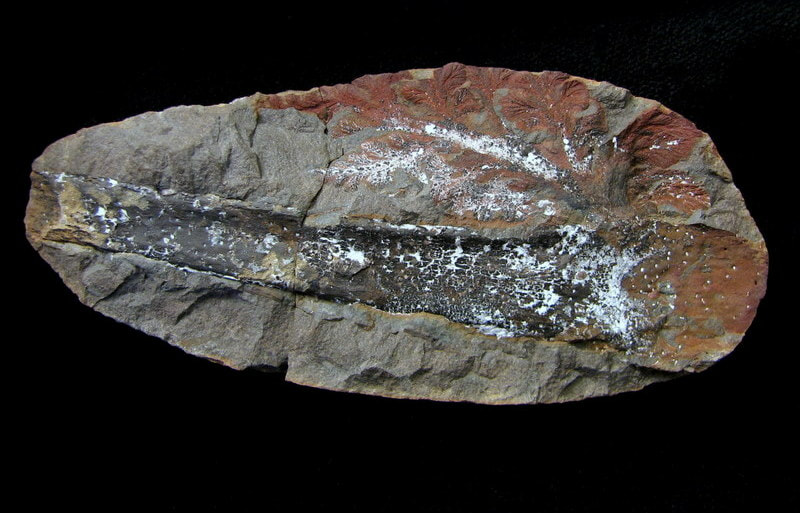Selected Projects
The Mazon Creek Fossil Fauna
Paleontological Book Publication
ESCONI and Northeastern University, October, 2012
|
In 2005, the same year that a friend in the art world introduced me to fossil collecting in the Midwest, I met Jack Wittry who’s had a longstanding relationship with Chicago’s Field Museum and its Paleobotony department. By our discussions there, I learned that Jack and the Earth Science Club of Northern Illinois were preparing to publish a book on the plants of Illinois during the Carboniferous Period (300 Mya), using many of the museum’s specimens in the illustrations. On the back burner was the idea to eventually produce a complimentary book of the animals from the same time period and locality.
In the seven years following my discovered – and one might say, passionate – interest in Mazon Creek paleontology, I’ve invested myself further with institutions promoting research on the subject. I found a very distinct connection to the art work I make, specifically that which addresses evolution and the human relationship to landscape and natural resources. (See Projects – Indexing the World: invention, abstraction and dissonance.)What ensued was an invitation to participate in the making of the second book, The Mazon Creek Fossil Fauna, specifically in the areas of writing, editing, drawing and photography. |
The Mazon Creek Fossil Fauna front cover, 2012.
The book is available esconi.org. |
|
Jack Wittry in the Paleobotany Collections
at The Field Museum, 2011. |
The book, released in October, 2012, is the result of a cooperative effort of numerous people, including collectors, amateur and professional of paleontologists, writers, artists, graphic designers, and photographers. I was named a co-editor, under Jack Wittry’s leadership, along with Joan Bledig, owner of JDA Typesetting and publisher with Loyola Press. It was a privilege to author the introductory chapter of the book and contribute to the whole of its content, often in collaboration with experts in the field. I want to express a special appreciation to Marie Angkuw, Catherine O'Brian, and Charles Snoad for all of their assistance in reviewing the text portion of the volume.
|
|
Below is the Foreword of the book, written by Charles Shabica, who was part of the major study of the animals and environmental phenomena of Mazon Creek. An illustrated PDF of my essay, entitled Coal, Shale, and Ironstone: The Paleontology of Mazon Creek and Its Great Faunal Discoveries, can be found at this link.
|
Dunbarella striata bivalve
Illustration by Andrew Young. |
A Field Museum artist’s rendition of a Carboniferous Period forest.
|
Mazonomya mazonensis bivalve
Illustration by Andrew Young. |
Foreword
The Mazon Creek Biota of Illinois represents the most complete record known of a late Paleozoic community of animals and plants. As a Konservat-Lagerstätte (a deposit with exceptional fossil preservation), this extraordinary fossil assemblage ranks among other great fossil sites, such as the Precambrian Ediacara of Australia, the Cambrian Burgess Shale of Canada, the Devonian Bundenbach, and the Jurassic Solnhofen of Germany. Occurring in the 307 million-year-old Middle Pennsylvanian Francis Creek Shale, the Mazon Creek Biota comprises one of the most diverse fossil floras in North America, and also encompasses more than 500 animal species representing 11 phyla and 23 classes. |
|
Many soft-bodied groups are represented among the fossil specimens, as well as insects and complete vertebrate skeletons with soft parts. All were rapidly buried during a catastrophic flood event. The stage was set by global warming and a change in tropical climate from wet (widespread equatorial coal swamps) to monsoonal. Alternating wet and dry seasons repressed plant growth and spawned intense upland erosion and delta progradation. Terrestrial, freshwater, estuarine, and a few marine organisms succumbed to the rain of river-borne silt and clay, and are beautifully preserved in siderite (iron carbonate) nodules. Rising sea level caused by melting of the south polar icecap and compacting delta sediments assured their preservation in the geologic record. The site, located near Chicago, is accessible to hundreds of amateur collectors who are responsible for most of the rare animals and plants of the Mazon Creek area that are exhibited in museum collections.
|
Joan Bledig, Jack Wittry, and Andrew Young identifying specimens at he Chicago Academy
of Sciences Collections, 2012. |
|
Marie Angkuw and Catherine O'Brian reviewing
text for The Mazon Creek Fossil Fauna in a Field Museum classroom, 2012. |
The Mazon Creek Fossil Fauna is a complete and updated taxonomic guide to this important assemblage and includes descriptions and color photos of species that collectors are likely to find in the field or see in most large collections. Some extremely rare species or insects whose descriptions are based on a single part or wing are omitted. This book was conceived by the Earth Science Club of Northern Illinois (ESCONI) as a continuation of earlier publications on the subject. It represents an evolution of Mazon Creek works published by ESCONI, including two books by George Langford, Sr. (1958 and 1963) and, more recently, Keys to Identify Pennsylvanian Fossil Animals of the Mazon Creek Area, by Andrew A. Hay, et al. (1989). This new volume, The Mazon Creek Fossil Fauna, edited by Jack Wittry, Research Fellow at Northeastern Illinois University, is a collaboration with Joan Bledig, Andrew Young, and other ESCONI members. For more than 60 years, ESCONI has supported Mazon Creek collecting, museum accessions, and research. Today, Jack Wittry and his ESCONI colleagues continue this long tradition of unselfish sharing of time and talent with the scientific community.
|
|
With high-quality color photographs of fossils from the collections of The Field Museum of Natural History, the Chicago Academy of Sciences, and amateur collectors, The Mazon Creek Fossil Fauna will be a valuable tool for fossil identification by collectors as well as professionals. It is a companion volume to the well-received publication, The Mazon Creek Fossil Flora (2006), written by Wittry and published by ESCONI. Together, these books provide a clear window into the past, as revealed through this great fossil bonanza, Mazon Creek.
Charles W. Shabica, Emeritus Professor Northeastern Illinois University Chicago, Illinois |
A rare Rhacophyllum cornutum plant specimen, showing basal “bulb” attachment (length: approx. 7 in.). Found in coal strip mining spoils of the Mazon Creek area, it was donated in 2011 from the Andrew Young Collection to The Field Museum.
|
Project images include field collecting and specimen photos of various Mazon Creek Carboniferous animal species.
© The above artworks may be protected by copyright. They are posted on this site in accordance with
fair use principles, and are only being used for informational and educational purposes.
fair use principles, and are only being used for informational and educational purposes.
